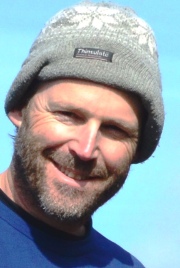Ten good news nature conservation stories from 2018: Our collective actions can have a big impact
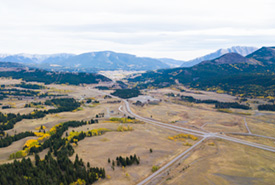
Lands within the Jim Prentice Wildlife Corridor (Photo by Brent Calver)
Around the world, we are at a crossroads in our relationship with the planet. For the first time in human history our environmental impacts are happening at a scale that is affecting all life on Earth.
Our collective experience in solving big, planetary issues is all very recent. In the past, people managed environmental impacts at the scale of our tribe, territory or region. We are one of the first generations that need to think about problem solving on really big scales.
2018 had some bad news for nature. The latest report by the Intergovernmental Panel on Climate Change warns that time may be running out for effective action on climate change. At the same time, climate change is being used to polarize and reinvigorate the long-debunked idea that economy, environment and well-being are somehow competing interests. Global wilderness is continuing to shrink, and the U.S. is edging closer to opening up the Arctic National Wildlife Refuge to drilling. Our list of globally threatened wildlife has grown to over 26,500 species, and many wildlife populations are declining. In Canada, iconic wildlife like caribou are in trouble, and the Atlantic Whitefish, perhaps Canada’s most endangered species, may be doomed to extinction.
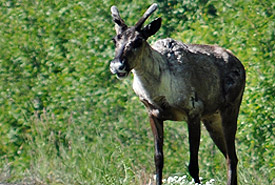
Caribou (Photo by NCC)
These are all big complex problems, but individuals and organizations are working to solve them. Our current environmental issues, from climate change to biodiversity loss, are the result of many collective impacts, and we can only solve them through many collective solutions.
The foundation of sustainability needs a range of opinions, ideas and solutions. It needs messages of urgency, but also messages of hope. Here are 10 stories of hope from 2018. They are evidence that solutions exist for a sustainable future and for a renewed human relationship with nature.
1. The number of protected areas is continuing to grow
The total area of parks and protected areas now tops over 20 million km2, or about 15 per cent of the planet’s lands and inland waters. Through the collective conservation efforts of all nations, it appears we will meet the global target of protecting 17 per cent by 2020. There were several monumental new parks announced in 2018. Columbia established the world’s largest protected tropical rainforest, and a massive new park was established in Chile thanks to land donations from Douglas Tompkins, founder of the North Face. Here in Canada, more than 20 per cent of Nunavik in northern Quebec is now protected from industrial development, and Canada’s first Indigenous protected area was established: the Edéhzhíe Protected Area in the Northwest Territories.
2. Keeping fish in the sea
We should all be encouraged by the global expansion of marine protected areas in our oceans. Between 2016 and 2018, the amount of marine protected areas increased from 10.2 per cent to 16.8 per cent. In 2018, Brazil increased its marine protected areas by 25 per cent, and the government of Seychelles announced the creation of two new marine protected areas covering 210,000 km2. In addition to protecting more marine areas, there were many important initiatives to reduce unsustainable fishing practices, such as a ban on drift net fishing in California, new measures to protect forage fishes off the eastern coast of the U.S. and a moratorium on commercial fishing in the waters of the high Arctic.
3. Big parks and big corridors in Alberta
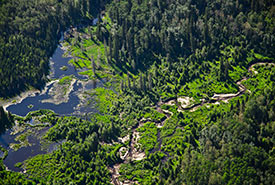
Boreal forest by Fort McMurray, AB (Photo by Michel Rapinski)
Alberta had several big protected area announcements in 2018. In the Rocky Mountains, the province has released plans to establish more protected areas in Bighorn County, and the Nature Conservancy of Canada (NCC) announced the Jim Prentice Wildlife Corridor project. Both of these initiatives will protect important areas and help to maintain connectivity for wildlife. In northern Alberta, new and expanded parks were established around Wood Buffalo National Park. This includes the Birch River Wildlands Park, protected through a unique series of agreements between the Tallcree Tribal Government, NCC, the governments of Alberta and Canada and Syncrude Canada. This network of parks has created the largest protected boreal forest in the world.
4. If you conserve and restore it, they will come
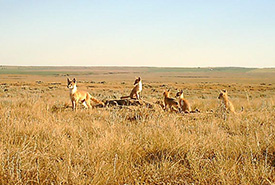
Swift foxes (Photo by NCC)
Nature's resiliency should give us hope. Given a chance, many species will return if we protect and restore their habitats and reduce critical threats to their populations. Many species are now rewilding the European landscape, including wolves, bears and golden jackals. In Canada, one of the greatest wildlife recovery stories (so far) is the return of the swift fox. In 2018, a den of swift foxes was discovered on an NCC conservation site in southeast Alberta. There are also an increasing number of examples of how species return when we restore their habitats. In Newfoundland, the World Wildlife Fund restored a beach that allowed capelin to return and spawn.
5. Big hope in a small package
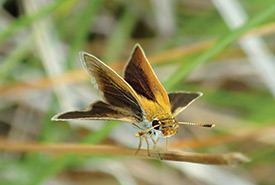
Poweshiek skipperling (Photo by Rachel Carol)
Over 99 per cent of North America’s tall grass prairie has been lost, and much of the remainder is threatened by invasive species and fragmentation. As a result, many of the species that live here are at risk of extinction. Today, less than 100 Poweshiek skipperlings remain in Canada. This small butterfly is restricted to southeastern Manitoba and a site near Flint, Michigan. This precarious population got a little larger this summer when the Assiniboine Park Conservancy Conservation and Research Department successfully released six captive-reared Poweshiek skipperlings at NCC's Tall Grass Prairie Natural Area. The marks the first-ever release of captive-reared Poweshiek skipperlings, both in Canada and the U.S. The program will be expanded next year to hopefully release more adults onto NCC properties and stop the extinction of this species.
6. Key Biodiversity Areas to guide conservation
We can’t protect important places for nature if we don’t know where they are. Key Biodiversity Areas (KBAs) are a global initiative to identify and map these places around the world. In Canada, Important Bird Areas and some freshwater KBAs have been identified, including Brier Island in Nova Scotia. Wildlife Conservation Society Canada and partners will lead in identifying other KBAs across the country in the coming years.
7. Technology for nature
Technology can certainly distract us from nature, but it can also inform and inspire action. A great example is Canada’s new online marine atlas prepared in 2018 by Oceans North Conservation Society, World Wildlife Fund Canada and Ducks Unlimited Canada. Technology can also allow everyone to participate in conservation and contribute to our collective knowledge. In 2018, iNaturalist reached over one million users around the world. With over 500 million eBird observations from around the world, scientists are learning more about birds and creating amazing maps that show the abundance of and migration for many species.
8. Historical investment in Canadian conservation
In 2018, the Government of Canada announced $1.3 billion dollars of new federal funding over five years to protect Canada’s lands, oceans and wildlife. This unprecedented investment will support Canada’s efforts to achieve our commitment to protect at least 17 per cent of our lands and 10 per cent of our oceans by 2020. This funding will support new federal protected areas, conservation partnerships with Indigenous Peoples and species at risk protection. The funding includes $500 million for a Canada Nature Fund to support conservation partnerships that will be matched by provincial, private and other funds.
9. Growing awareness in conservation
Nature conservation is ultimately about people and our relationship with the natural world. The theme at NCC’s NatureTalks speakers' series in 2018 was about this relationship, how it’s changed and why it’s important for the future. Fortunately, interest and support for conservation remains high. Google recently reported an increase in searches about conservation. A poll by the Canadian Parks and Wilderness Society in June 2018 found that support for conservation remains high, with 93 per cent of Canadians agreeing that protected areas are necessary.
10. Nature for all
In November, the International Union for Conservation of Nature launched a new publication, Connecting with Nature to Care for Ourselves & the Earth, which highlights the most current and compelling evidence for engaging and connecting people with nature. The publication provides evidence on the essential role that nature plays in all of our lives, and provides guidance on policies and practices that can help us all better link nature and our own well-being.

